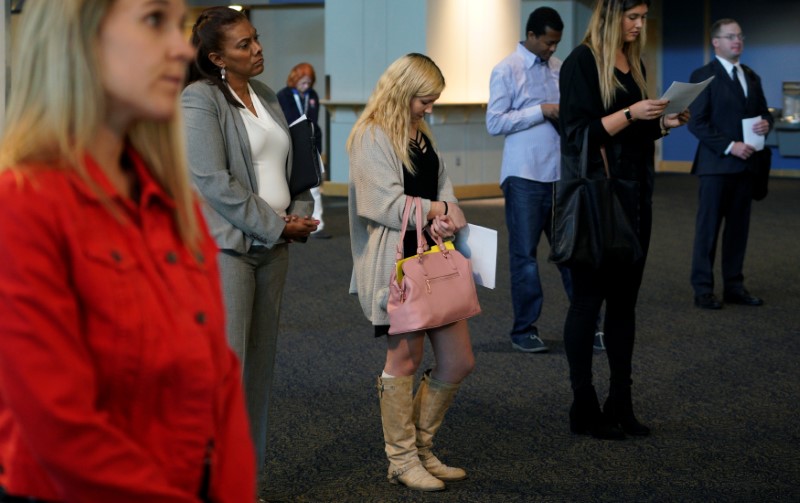By Lucia Mutikani
WASHINGTON (Reuters) - U.S. job growth increased at a strong clip in November, painting a portrait of a healthy economy that analysts say does not require the kind of fiscal stimulus that President Donald Trump is proposing, even though wage gains remain moderate.
Nonfarm payrolls rose by 228,000 jobs last month amid broad gains in hiring as the distortions from the recent hurricanes faded, Labor Department data showed on Friday. The government revised data for October to show the economy adding 244,000 jobs instead of the previously reported 261,000 positions.
Employment gains in October were boosted by the return to work of thousands of employees who had been temporarily dislocated by Hurricanes Harvey and Irma. November's report was the first clean reading since the storms, which also impacted September's employment data.
Average hourly earnings rose five cents or 0.2 percent in November after dipping 0.1 percent the prior month. That lifted the annual increase in wages to 2.5 percent from 2.3 percent in October. Workers also put in more hours last month.
The unemployment rate was unchanged at a 17-year low of 4.1 percent amid a rise in the labour force. Economists polled by Reuters had forecast payrolls rising by 200,000 jobs last month.
The fairly upbeat report underscored the economy's strength and could fuel criticism of efforts by Trump and his fellow Republicans in the U.S. Congress to slash the corporate income tax rate to 20 percent from 35 percent.
"The labour market is in great shape. Tax cuts should be used when the economy needs tax cuts and it doesn't need tax cuts right now," said Joel Naroff, chief economist at Naroff Economic Advisors in Holland, Pennsylvania. "When politics and economics are mixed in the stew, the policies that are created often have a very awful smell."
Republicans argue that the proposed tax cut package will boost the economy and allow companies to hire more workers. But with the labour market near full employment and companies reporting difficulties finding qualified workers, most economists disagree. Job openings are near a record high.
The economy grew at a 3.3 percent annualised rate in the third quarter, the fastest in three years, and appears to have maintained the momentum early on the October-December quarter.
The average workweek rose to 34.5 hours in November, the longest in five months, from 34.4 hours in October. Aggregate weekly hours worked surged 0.5 percent last month after October's 0.3 percent gain.
"A six-minute increase in the work week does not sound like much, but given the size of the labour market, it turns out to be significant in terms of output," said Marc Chandler, global head of currency strategy at Brown Brothers Harriman in New York.
The dollar was trading higher against a basket of currencies, while prices for U.S. Treasuries fell. Stocks on Wall Street rose.
FULL EMPLOYMENT
While November's employment report will probably have little impact on expectations the Federal Reserve will raise interest rates at its Dec. 12-13 policy meeting, it could help shape the debate on monetary policy next year.
The U.S. central bank has increased borrowing costs twice this year and has forecast three rate hikes in 2018.
Employment growth has averaged 174,000 jobs per month this year, down from the average monthly gain of 187,000 in 2016. A slowdown in job growth is normal when the labour market nears full employment.
The economy needs to create 75,000 to 100,000 jobs per month to keep up with growth in the working-age population.
The unemployment rate has declined by seven-tenths of a percentage point this year. A broader measure of unemployment, which includes people who want to work but have given up searching and those working part time because they cannot find full-time employment, ticked up to 8.0 percent last month from a near 11-year low of 7.9 percent in October.
Economists believe the shrinking labour market slack will unleash a faster pace of wage growth next year. That, combined with the tax cuts, would help to boost inflation.
"Detractors will argue that wage increases are too slow but we have shown in our research that adjusting for demographic effects, wage gains are where one ought to expect them to be," said John Ryding, chief economist at RDQ Economics in New York.
"As the labour market continues to tighten, we are confident that average hourly earnings will rise above 3 percent next year."
The growth in employment was broad in November. Construction payrolls increased by 24,000 jobs, thanks in part to rebuilding efforts in the areas devastated by the hurricanes, after rising 10,000 in October.
Manufacturing scored another month of solid job gains, with payrolls increasing by 31,000 jobs after rising 23,000 in the prior month. Retail payrolls grew by 18,700 jobs last month, the largest gain since January, likely boosted by hiring for the holiday season.
Employment at department stores increased by 3,100 jobs last month. Retailers, including Macy's Inc, reported strong Black Friday sales. Macy's said this month it would hire an additional 7,000 temporary workers for its stores to deal with heavy customer traffic in the run-up to Christmas.
